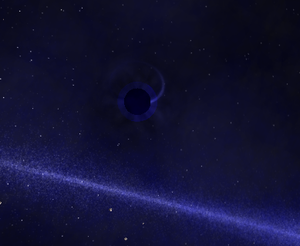Black Hole (Celestial): Difference between revisions
mNo edit summary |
(Updated) |
||
| Line 1: | Line 1: | ||
{{DISPLAYTITLE:Black Hole ''(Celestial)''}}[[file:BlackHole.png|thumb|right|An eerie black hole.]] | {{DISPLAYTITLE:Black Hole ''(Celestial)''}}[[file:BlackHole.png|thumb|right|An eerie black hole.]] | ||
'''Black holes''' can exist in [[Solar_System|solar system]]s in place of normal [[star]]s. Black holes have strong gravity and should be avoided with any non-gravity based propulsion crafts, such as [[Space_Rocket|space rocket]]s and [[Rocket_Drive|rocket drive]] [[spacecraft]]. | |||
Black holes can exist in [[Solar_System|solar system]]s in place of normal [[star]]s. Black holes have strong gravity and should be avoided with any non-gravity based propulsion crafts, such as [[Space_Rocket|space rocket]]s and [[Rocket_Drive|rocket drive]] [[spacecraft]]. | |||
==Wormholes== | ==Wormholes== | ||
Black holes cannot have any [[wormhole]]s, if a black hole is the main sequence in the [[Solar_System|solar system]], the interstellar wormhole will be around a companion [[star]] instead. | Black holes cannot have any [[wormhole]]s, if a black hole is the main sequence in the [[Solar_System|solar system]], the interstellar wormhole will be around a companion [[star]] instead. | ||
Like [[Supermassive_Black_Hole|supermassive black hole]]s, there are intergalactic neutral wormholes around a normal black hole. However, be warned that '''these are one way''', as there is no accompanying wormhole on the other side. In addition, these will usually put you in deep space of a solar system, with the destination solar system chosen depending on your relative distance to the core in your current galaxy. For example, if you were at the edge of the source galaxy, you'd have a one-way trip to the edge of the destination galaxy, even if it's far smaller or far larger. | |||
[[Category:Science]] | [[Category:Science]] | ||
Latest revision as of 06:03, 1 March 2024

Black holes can exist in solar systems in place of normal stars. Black holes have strong gravity and should be avoided with any non-gravity based propulsion crafts, such as space rockets and rocket drive spacecraft.
Wormholes
Black holes cannot have any wormholes, if a black hole is the main sequence in the solar system, the interstellar wormhole will be around a companion star instead.
Like supermassive black holes, there are intergalactic neutral wormholes around a normal black hole. However, be warned that these are one way, as there is no accompanying wormhole on the other side. In addition, these will usually put you in deep space of a solar system, with the destination solar system chosen depending on your relative distance to the core in your current galaxy. For example, if you were at the edge of the source galaxy, you'd have a one-way trip to the edge of the destination galaxy, even if it's far smaller or far larger.